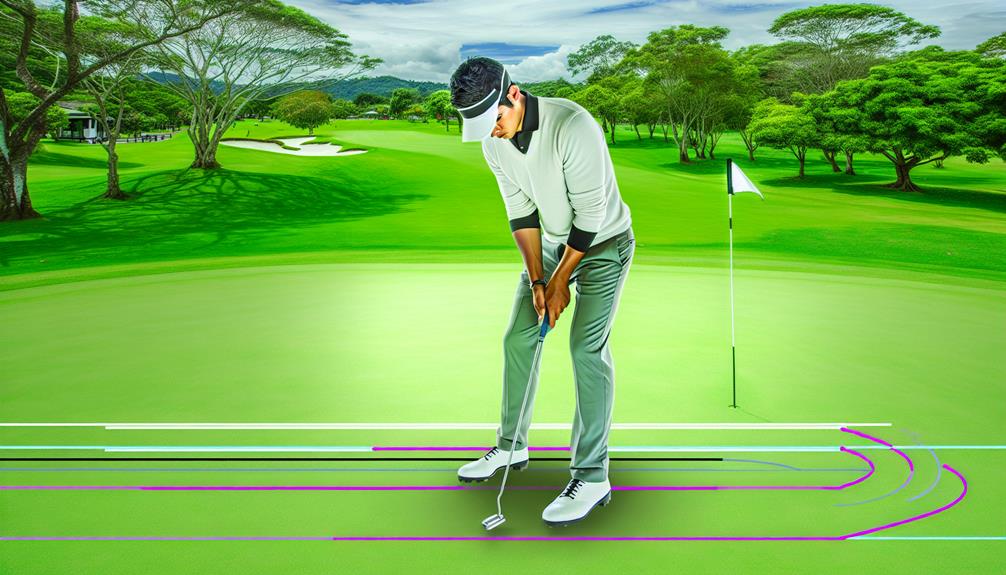'Practice makes perfect,' they say, and nowhere is this truer than in mastering the art of putting in golf. You've probably found yourself wondering why some golfers excel on the green while others struggle, despite seemingly similar skill levels.
Well, it often boils down to a few critical strategies and techniques. From understanding the basics and perfecting your stance, to mastering speed and distance control, rest assured that there's always room for improvement in your putting game.
But how do you integrate these techniques and strategies into your play? Stick around, and you'll discover just that.
Understanding Golf Putting Basics
To master the art of golf putting, you need to first grasp the basic techniques, from correctly positioning your body to understanding how to control the putter's speed and direction.
Begin with grip fundamentals. You must hold the club correctly to ensure accurate and powerful shots. The handle should rest against the base of your fingers with the thumb pointing down the shaft. This type of grip allows you to maintain control without excess pressure.
In addition to the grip, your stance plays a big role. Place your feet shoulder-width apart and square your body to the target. This positioning enables you to swing the putter straight back and through, enhancing accuracy and consistency.
Your mental preparation is equally crucial. Golf is a game of patience and concentration. Before each putt, visualize the ball's path, focus on the target, and clear your mind of distractions. This mental imagery boosts confidence and improves your overall performance.
Perfecting Your Putting Stance
Perfecting your putting stance is a crucial step in improving your golf game, requiring careful attention to body alignment, balance, and stability. To start, consider your grip techniques. Your grip on the club should be firm but relaxed, and your hands should align with the putter's face to direct the ball accurately.
You can explore stance variations to find what suits you best. Some golfers prefer a square stance, with feet parallel to the target line, while others adopt an open stance with the left foot slightly back. No matter your preference, it's essential to ensure your weight is evenly distributed between both feet, providing a stable base for your stroke.
Your eyes should be over the ball, allowing you to see the line without turning your head. Your arms and shoulders need to form a triangle, which will remain static during the stroke. This setup promotes a smooth pendulum motion, with your shoulders driving the stroke while your grip remains steady.
Importance of Accurate Aim
Once you've honed your stance, achieving accurate aim becomes your next critical target in mastering the art of putting in golf. Proper aim sets the foundation for a successful putt and, when done with precision, it can significantly reduce your scores.
Aiming consistency is crucial in maintaining your aim's accuracy. It's about repeatedly executing the same movements and aligning the clubface correctly towards the target with each putt. This requires a blend of mental focus and muscle memory, both of which you'll develop with constant practice.
Another important aspect is target visualization. It's not just about seeing the hole; it's about visualizing the precise path your ball should take to reach it. This includes considering factors like green speed, slope, and grain direction. By visualizing the target and the path, you're programming your brain and body to work together towards that aim.
Mastering Speed and Distance Control
Getting a handle on speed and distance control is a game changer in your golf putting technique. Mastering these skills can drastically reduce your number of strokes and, ultimately, your golf score.
When focusing on speed, stroke consistency is key. A consistent stroke allows you to better predict the speed at which the ball will travel, and subsequently, how far it'll go. Practice makes perfect; spend time on the green to develop a feel for different stroke intensities and how they affect ball movement.
Distance control, on the other hand, is about understanding the terrain and adjusting your stroke accordingly. Uphill puts will naturally require more force while downhill puts will require less. Visualize the path your ball will take, then execute your stroke with that image in mind.
Don't overlook the importance of equipment selection. Different putters have varying degrees of face loft and weight, which can influence ball distance and speed. Experiment with different putters to find one that complements your technique and enhances your control.
Implementing Precision in Green Reading
While mastering speed and distance control is crucial, it's equally important to implement precision in reading the green. This crucial skill requires an understanding of grain analysis and slope evaluation.
Grain analysis involves examining the grass on the green. You'll want to observe the direction in which the grass is growing, as it can significantly affect your putt's speed and direction. Usually, grass grows towards the sunlight or water source, so you'll find that putts will roll faster downhill or with the grain and slower uphill or against the grain.
Slope evaluation, on the other hand, involves understanding how the topology of the green affects the ball's path. You'll need to assess the contours of the green and predict how they'll influence the ball's movement. Whether it's an uphill, downhill, or sidehill slope, each presents unique challenges that you'll need to consider when planning your putt.

